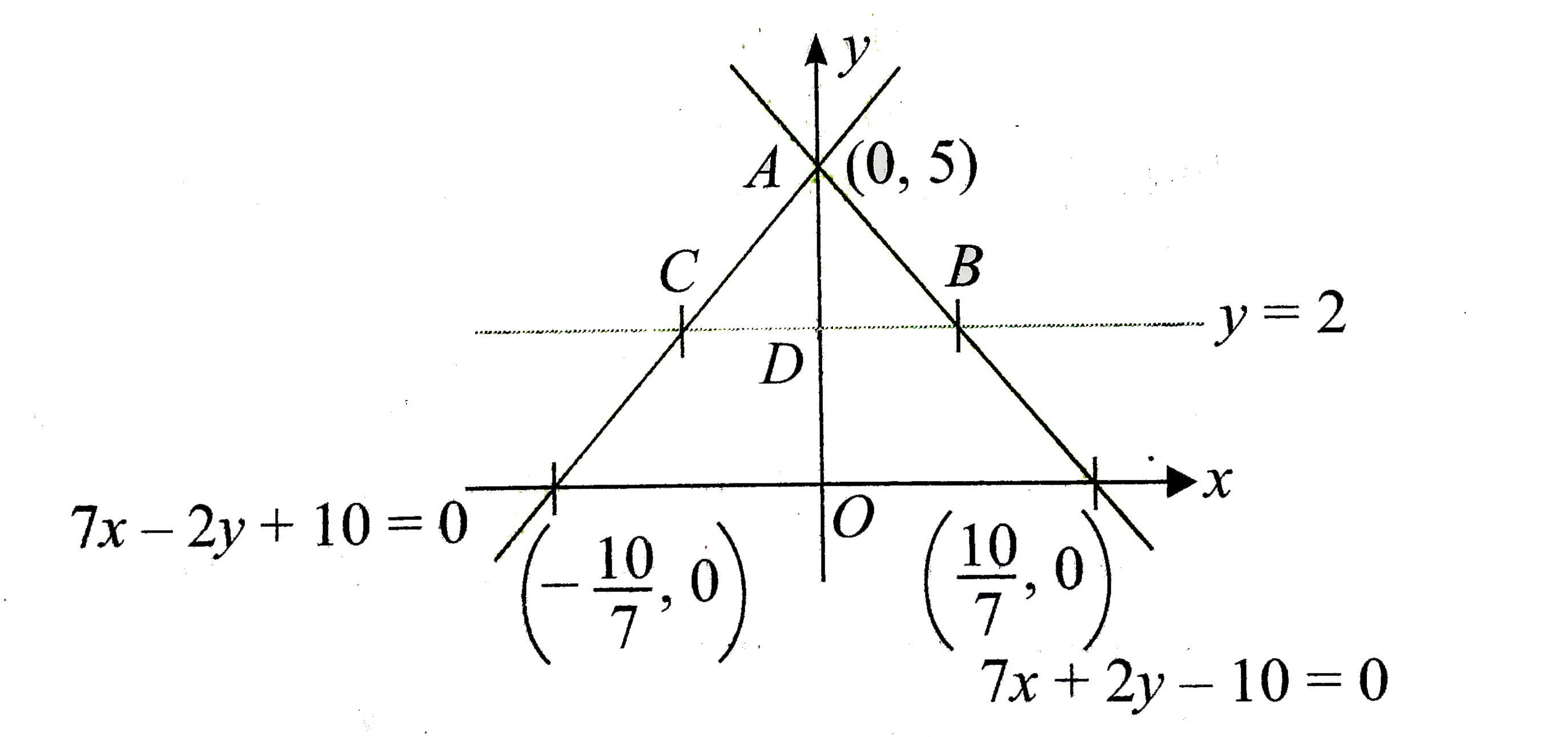The straight lines 7x−2y+10=0 and 7x+2y−10=0 form an isosceles triangle with the line y=2. The area of this triangle is equal to (a)157sq.units (b) 107sq.units (c)187sq.units (d) none of theseSolution in Tamil
15/7 sq. units
10/7 sq. units
18/7 sq. units
none of these
The correct Answer is:C
We have
B≡(67,2),C≡(−67,2)
or BC=127,AD=3

∴ΔABC=12×127×3=187 sq. units
Topper's Solved these Questions
- STRAIGHT LINESBOOK - CENGAGECHAPTER - STRAIGHT LINESEXERCISE - Exercise (Multiple)
30 Videos
- STRAIGHT LINESBOOK - CENGAGECHAPTER - STRAIGHT LINESEXERCISE - Exercise (Comprehension)
27 Videos
- STRAIGHT LINESBOOK - CENGAGECHAPTER - STRAIGHT LINESEXERCISE - Exercise 2.6
5 Videos
- STRAIGHT LINEBOOK - CENGAGECHAPTER - STRAIGHT LINEEXERCISE - Multiple Correct Answers Type
8 Videos
- THEORY OF EQUATIONSBOOK - CENGAGECHAPTER - THEORY OF EQUATIONSEXERCISE - JEE Advanced Previous Year
9 Videos
Similar Questions
If P is a point (x,y) on the line y=−3x such that P and the point (3, 4) are on the opposite sides of the line 3x−4y=8, then x>815 (b) x>85 y<−85 (d) y<−815
View SolutionLet L be the line belonging to the family of straight lines (a+2b) x+(a-3b)y+a-8b =0, a, b ∈R, which is the farthest from the point (2, 2).
Area enclosed by the line L and the coordinate axes is
View SolutionIf aandb are two arbitrary constants, then prove that the straight line (a−2b)x+(a+3b)y+3a+4b=0 will pass through a fixed point. Find that point.
View SolutionThe point P(α,α+1) will lie inside the triangle whose vertices are A(0,3),B(−2,0) and C(6,1) if
View SolutionQ. Let p and q real number such that p≠0,p2≠q and p2≠−q. if α and β are non-zero complex number satisfying α+β=−p and α3+β3=q, then a quadratic equation having αβ and βα as its roots is
View SolutionThe area of the closed figure bounded by x=−1,x=2,and y={−x2+2,x≤12x−1,x>1andtheabscissaaξsis 163sq.units (b) 103sq.units 133sq.units (d) 73sq.units
View SolutionA straight line passing through P(3,1) meets the coordinate axes at AandB . It is given that the distance of this straight line from the origin O is maximum. The area of triangle OAB is equal to 503sq.units (b) 253sq.units 203sq.units (d) 1003sq.units
View SolutionThe straight lines 7x−2y+10=0 and 7x+2y−10=0 form an isosceles triangle with the line y=2. The area of this triangle is equal to 157sq.units (b) 107sq.units 187sq.units (d) none of these
View SolutionA tangent having slope of −43 to the ellipse x218+y232=1 intersects the major and minor axes at point AandB, respectively. If C is the center of the ellipse, then the area of triangle ABC is 12sq.units (b) 24sq.units 36sq.units (d) 48sq.units
View SolutionA particle of mass m is moving anticlockwise, in a circle of radius R in x−y plane with centre at (R,0) with a constant speed v2. If is located at point (2R,0) at time t=0. A man starts moving with a velocity v1 along the positive y-axis from origin at t=0. Calculate the linear momentum of the particle w.r.t. man as a function of time.
View SolutionArea of the triangle formed by the line x+y=3 and the angle bisectors of the pairs of straight lines x2−y2+2y=1 is 2sq.units (b) 4sq.units 6sq.units (d) 8sq.units
View SolutionA straight line passing through P(3,1) meets the coordinate axes at AandB . It is given that the distance of this straight line from the origin O is maximum. The area of triangle OAB is equal to 503sq.units (b) 253sq.units 203sq.units (d) 1003sq.units
View SolutionThe straight lines 7x−2y+10=0 and 7x+2y−10=0 form an isosceles triangle with the line y=2. The area of this triangle is equal to 157sq.units (b) 107sq.units 187sq.units (d) none of these
View SolutionArea of the triangle formed by the line x+y=3 and angle bisectors of the pair of straight lines x2−y2+2y=1 is 2sq.units b. 4sq.units c. 6sq.units d. 8sq.units
View SolutionThe straight lines 7x−2y+10=0 and 7x+2y−10=0form an isosceles triangle with the line y=2.The area of this triangle is equal to157sq.units (b) 107sq.units187sq.units(d) none of these
View SolutionThe area of the loop of the curve ay2=x2(a−x) is 4a2sq.units (b) 8a215sq.units 16a29sq.units (d) None of these
View Solution
